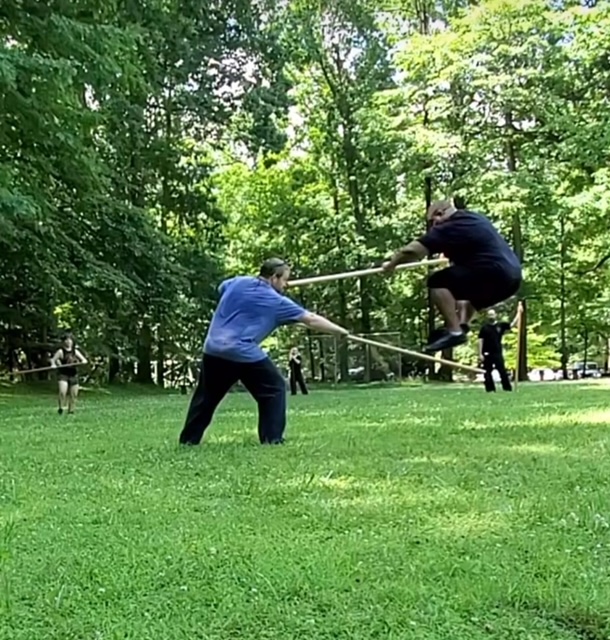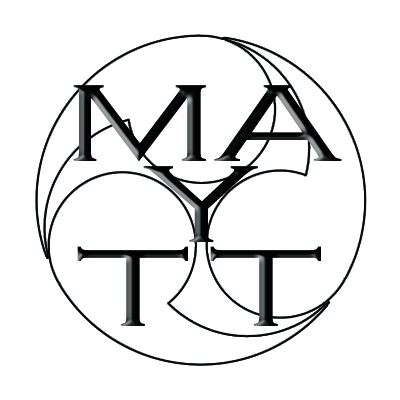The Japanese Ninja boom of the 1980s left a mark on Lee Relf, so much so that he sought out ninjutsu. He found it in Arizona with Peter Crocoll and quickly enjoyed what he was learning. Since then, Relf has trained with numerous instructors from Japan and Europe and opened his Bujinkan Seitaku Dojo. Today, Relf took some time to discuss more about Bujinkan Ninjutsu. All images provided by Lee Relf.
Martial Arts of Yesterday, Today, and Tomorrow: Welcome Relf Sensei! Thank you for joining us today!
Lee Relf: Thank you for the opportunity to participate in this interview.
MAYTT: You started Bujinkan Budo Taijutsu in 1984. What about the Bujinkan art that piqued your interest? What continues to motivate you to train today?

LR: As many in the late 1970s and early 1980s, the image of the ninja arrived in the US via movies and television shows. In Los Angeles, we had a channel that showed segments and news for the Japanese TV channel NHK. There, I saw many martial art segments and early ninja related movies and shows as the Japanese Ninja boom had already been going for more than fifteen years or more and I was sold.
When I found a Bujinkan Dojo (Divine Warrior Training Hall), specifically the Arizona Bujinkan Ninpo and Budo Kai, taught by Peter Crocoll Sensei, Tempe, Arizona, I knew this was what I wanted to be a part of. I started in karate arts, was exposed to Japanese Jujutsu, Kenpo and types of Kung Fu, which I loved each of those arts. Spent lots of time sparring in the dojo and at competitions, which as an athletic young man, forms I wasn’t as interested in learning as much. Fast forward forty years and having not only studied under the Hatsumi Sensei and top instructors of the art, but I’ve also applied many lessons from the art to my life, physically, mentally, and spiritually.
What really makes me continue is I could never learn everything in this art. For many of us, taijutsu or body art, is an endless life-long journey. You are never there or finished, let alone know everything within the nine arts. Techniques-wise, we have kata or fundamental training forms mostly done against a partner, then we have henka or variations. Henka are usually based on something changing to where you can’t do the original kata concept, so you must overcome. Then we have kaeshi-waza or how to beat the kata or waza. Next, we have application which is how to use the kata in the most practical manner. Somewhere in between each of these four concepts are usually ura gata/waza which are usually not shared publicly.
MAYTT: How would you describe the training you experienced when you first started Bujinkan Budo Taijutsu? How have you seen the training change or evolve since you joined?
LR: What I loved about Bujinkan training in the 1980s was a no-nonsense approach to application of the techniques. Coming from arts that did a lot of sparring, there were no doubts in my mind the techniques were sound, practical, and effective, though the body movements were generally different from other arts. Towards the mid to late 1980s, many of us in the US determined we were not learning what was being taught in Japan by Grandmaster Masaaki Hatsumi and the master instructors under his guidance. Our training primarily was an adaptation from Stephen K. Hayes that had many of the same principles, though whenever the Japanese came to the US, it was very apparent, we were not doing the same art or had the same focus. Hatsumi Sensei said many times over the years to teach the arts in conjunction with trends and threats found in each of our countries, which I think Hayes was very successful at that.
During the 1980s and beyond, many of our teachers went to Japan and sought legitimate training sources independently by welcome of the Japanese master instructors and Hatsumi Sensei, which a shift in being more involved with the Bujinkan Dojo and Hatsumi Sensei was our focus versus other groups and interests. This direct connection with the source gave many of us our own perspective of the kihon (fundamentals) and nine arts found within Togakure-ryu Ninjutsu of the Bujinkan Dojo. Also, I believe Hatsumi Sensei perceived many were not getting what he was teaching then changed our focus to actually learning the nine Bujinkan arts versus pure application methods. Hatsumi Sensei changed our name to Togakure-ryu Ninpo, then other variations including the Bujinkan name, which he finalized our system as Bujinkan Budo Taijutsu within the Bujinkan Dojo.
In the 1990s and early 2000s, our training was very technically focused, while in the early 2000s, Hatsumi Sensei primarily taught advanced concepts to the senior instructors. This created an environment by design world-wide where Shidoshi (instructors) or godan (5th degree black belts and above) would hold kihon and ryu-ha gata training in their dojo and sometimes regionally, Shihan and Dai-shihan (Master Instructors) could focus on their training with Hatsumi Sensei and develop lower ranked teachers and dojos. Some groups are very focused on the training they receive from Japan, and there are groups that seem to have an “evolution” mentality and incorporate other martial arts into their curriculum, though some appear distant from the curriculum of the art.
MAYTT: Your first instructor was Peter Crocoll. What was he like as an instructor and how did he come to the Bujinkan Budo Taijutsu?
LR: Peter was and is a technical professional, always a student of our master instructors, which I’ve modeled my training and development after. Peter spent several years training in Aikido prior to the Bujinkan Dojo, though I will defer to his commentary about how he came to the art. Peter embodies many of the core gentleman warrior competencies taught in the Bujinkan Dojo by Hatsumi Sensei and his Ninniku Seishin or Spirit of Perseverance is very deep.
MAYTT: When did you first start teaching? What was that experience like for you and how did that help you become the instructor you are today?
LR: After a few years in the dojo under Peter Crocoll Sensei, I became an assistant instructor helping in class and holding additional classes outside the regular hour for those interested in additional training and sparring. The experience was great as I was responsible for demonstrating what I knew to that point and many times found myself in a role where I dealt with dojo crashers, challengers, and those that were just plain troublemakers. Overall, I developed a level of patience and perseverance demonstrated by my teacher, which was not just in class as a teacher, but working out with students the entire night, which I find is my preferred way to share the art.
MAYTT: What factors influenced you to establish your Bujinkan Seitaku Dojo?
LR: After training in Europe under a few instructors, I moved to Maryland and trained with several groups for some years. I was still travelling to Japan regularly for training and wanted to share topics closer to what was happening there. During my time in the military, I became a firearms and Combatives Instructor (MMA) several years before, so I started out with private lessons in eight-week cycles for self-protection. After doing this for a few years, it conflicted a bit with my Bujinkan Dojo goals, so I devised a way to start a training group with only people that were interested in sparring and testing techniques. This group started in 2016, and using my martial art credentials I attracted a few folks interested in the art. From the first rough and tumble outdoor session, we became a new Bujinkan Dojo and formalized that year.

MAYTT: What is something that you wish people knew about Bujinkan Budo Taijutsu before coming into the dojo? Why do you think this is important to know?
LR: Many think we only use weapons and when they visit, they find that is very far from the truth. Our kihon are based on the distancing, timing, and balance associated with unarmed taijutsu concepts, which is important to know as it is the core and key to navigate through the techniques and concepts of the nine arts we study. It is very difficult to be a master in nine separate martial arts, let alone one. Many of our traditions are related, which makes ease of some overarching themes, though each are solid and separate martial traditions. Our kihon serve as a method to train in each art with usually small changes that help understand existing principles. Martial arts have wrist locks, throws, certain strikes, footwork, weapons, etc., though each are performed differently and in the way of that system. After much of my cross-training, my conclusion is most martial arts and even sport arts have more similarities than differences.
MAYTT: Who would you consider to be a pioneer of Bujinkan Budo Taijutsu here in the United States? In what ways did these disseminators set themselves apart from their peers?
LR: To me, the primary pioneer of the Bujinkan dojo in the US is Stephen K. Hayes. There were Americans that studied with Hatsumi Sensei before Hayes, though none stayed the course or had the wasta, way, charisma, or clout like he did to help Hatsumi sensei spread the art. Also, you’d have to mention Jack Hoban, Bud Malmstrom, Peter Crocoll, Darryl Caldwell, Dick Severance, Dale Seago, Charles Daniels, John Lindsay, Joe Maurantonio, and many others that are considered the first and second wave of instructors of the Bujinkan Dojo in the country.
MAYTT: In the next ten to fifteen years, where do you think Bujinkan Budo Taijutsu will be in the United States? In what ways will the art change or evolve, if at all?
LR: This is an interesting question. I’d like to think there are many schools in the US that are making deeper connections with the eight Japanese soke of the Bujinkan Dojo martial arts and have the intent to keep these arts alive. As of February 2024, Dai-shihan Sean Askew is the first American I know of that holds Menkyo Kaiden (License of Full Transmission) of one of our arts of the Bujinkan Dojo. This, for me, is such a big thing as he has been selected as a master of that specific art, with all of the responsibilities that may come from this title. Askew Sensei and his team organizes the annual Noguchi Sensei (Grandmaster of Koto Ryu Kosshijutsu) Tai Kai seminar, in which one of our top masters teaches in the US in the same fashion Hatsumi Sensei did world-wide for many years.
In the future, the kata of the nine arts of the Bujinkan may change very little or not at all. Their use and variations are limited to an individual’s taijutsu, so evolution is always happening based on natural movement concepts and training. This is the timeless aspect of the art we study. Thank you again for allowing me to participate and wish everyone great keiko (training)! Gambatte Kudasai! (Keep Going Please).
MAYTT: This was a great conversation!
LR: Thank you for having me!


